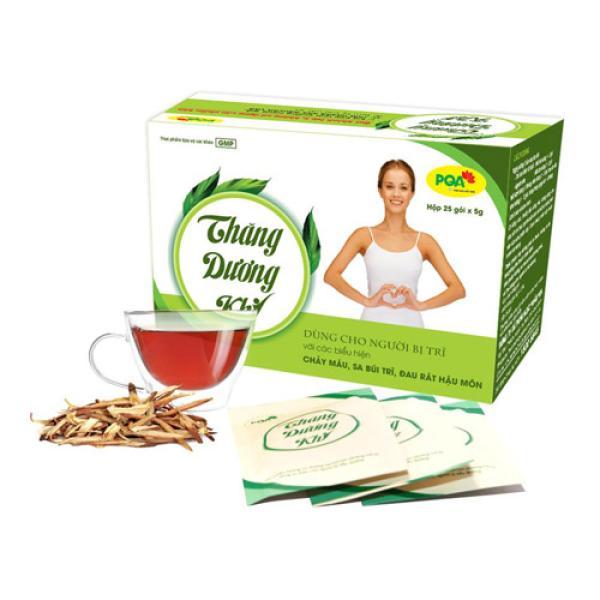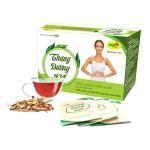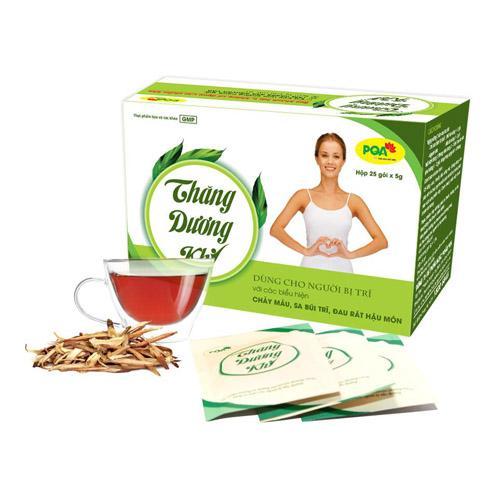THÔNG TIN DƯỢC PHẨM MTA THĂNG DƯƠNG KHÍ

INTRODUCTION TO MTA THANG DUONG KHI
MTA Thăng Dương Khí is an herbal-based medicinal product, formulated in granule form, specifically designed for individuals suffering from hemorrhoids. The product supports bowel regularity, enhances vascular wall integrity, and helps alleviate common symptoms of hemorrhoids.
COMPOSITION
Each 5g sachet contains herbal extracts equivalent to:
Astragalus (Hoàng kỳ): 500mg
Codonopsis (Đẳng sâm): 380mg
Atractylodes macrocephala (Bạch truật): 380mg
Angelica sinensis (Đương quy): 190mg
Cimicifuga (Thăng ma): 190mg
Bupleurum (Sài hồ): 190mg
Biota orientalis (Trắc bách diệp): 190mg
Sophora flower (Hòe hoa): 190mg
Licorice (Cam thảo): 150mg
Dried tangerine peel (Trần bì): 120mg
Excipients: sufficient for 1 sachet
KEY BENEFITS
MTA Thăng Dương Khí offers the following benefits:
Supports bowel movement and relieves constipation
Enhances the durability of blood vessel walls
Helps reduce symptoms associated with hemorrhoids
This product is suitable for those experiencing rectal bleeding, prolapsed hemorrhoids, and burning or pain in the anal area.
USAGE INSTRUCTIONS
Take 3 times daily on an empty stomach.
Dosage by age group:
Children over 12 years: 1–2 sachets per dose
Adults: 2–3 sachets per dose
Recommended treatment course:
Use continuously for 3 months per course. Afterward, to maintain effectiveness, dilute 1–2 sachets daily and use for an additional 3–6 months.
HEALTH WARNINGS
Shake or stir well before use due to possible herbal sedimentation.
Not suitable for pregnant women.
Not to be used by individuals with a history of allergy or adverse reactions to any of the ingredients.
Consult a doctor or healthcare professional before use to ensure safety and effectiveness.
Important Note: This is a health supplement, not a medicine, and is not intended to substitute for medical treatment.
MTA Thăng Dương Khí does not contain sucrose, making it suitable for diabetics.
STORAGE INSTRUCTIONS
Store in a cool, dry place, away from direct sunlight.
EXPIRY & REGISTRATION INFORMATION
Shelf life: 3 years from the date of manufacture
Manufacture date (MFG) and expiry date (EXP) are clearly printed on the product label.
Advertising approval number: 01495/2019/ATTP-XNQC
Product registration number: 2824/2019/ĐKSP

WHAT IS HEMORRHOIDS? CAUSES, SYMPTOMS, PREVENTION, AND TREATMENT
The fear of going to the toilet—straining, bleeding, pain. Avoiding bowel movements leads to stool accumulation for days, making the condition worse. Many silently suffer from this sensitive, hard-to-talk-about illness, turning hemorrhoids into a nightmare. But is hemorrhoids really as terrifying as you think? Let’s simplify the issue and tackle hemorrhoids in the article below.
What are hemorrhoids?
According to the 2017 report by the Vietnam Gastroenterology Association, the incidence of hemorrhoids in Vietnam is an astonishing 55%. The World Health Organization (WHO) also states that 50% of people aged 50 and above experience problems related to hemorrhoids.

Hemorrhoids are a condition of the vascular system, including arterioles, veins connecting arteries to smooth muscles and connective tissues. The venous plexus is supported by elastic fibrous tissue. Pressure applied to the plexus during constipation or straining during bowel movements causes blood congestion, leading to vein dilation and the formation of hemorrhoidal lumps.
Hemorrhoids are one of the leading causes of rectal bleeding. While hemorrhoids are not dangerous, if left untreated, they can progress into more serious complications that affect health and even life-threatening conditions.
Classification of Hemorrhoids
There are several ways to classify hemorrhoids, but primarily, they are divided into two types: internal hemorrhoids and external hemorrhoids, based on the location of the hemorrhoidal lumps.
Internal hemorrhoids: These are hemorrhoids that form inside the anus, on the mucosal surface. Internal hemorrhoids do not have sensory nerve fibers, so they do not cause pain, even though symptoms like bleeding may occur. Since they develop inside the anus, they are difficult to detect in the early stages.
Internal hemorrhoids typically have 4 stages:

Stages of Development of Internal Hemorrhoids
Stage 1: Hemorrhoidal lumps begin to form inside the anal canal.
Stage 2: The hemorrhoidal lumps protrude outside during bowel movements but return to their original position on their own.
Stage 3: The hemorrhoidal lumps protrude outside, and the person has to manually push them back inside.
Stage 4: The hemorrhoidal lumps are permanently protruding outside and cannot be pushed back inside.
External Hemorrhoids: These hemorrhoidal lumps form outside the anus. Because they have sensory nerve fibers, patients experience pain even without bowel movements. External hemorrhoids are visible with wrinkled skin around the anus and may cause inflammation or ulcers.
External hemorrhoids are easier to detect than internal hemorrhoids. However, many people are reluctant to treat the condition, which can cause the disease to progress and lead to complications that make treatment more difficult.
Additionally, there is a type of hemorrhoid that combines both internal and external hemorrhoids, called mixed hemorrhoids. Internal hemorrhoidal lumps develop and protrude outside, forming a mixed hemorrhoid.
Who is at Risk for Hemorrhoids?

People at Risk of Hemorrhoids
Individuals with constipation or diarrhea who frequently strain during bowel movements, increasing pressure on the veins and causing them to stretch and accumulate blood, forming hemorrhoids.
People with a diet lacking fiber, consuming hard-to-digest foods.
Overweight and obese individuals who place extra pressure on the anal veins.
People who frequently engage in heavy labor or strenuous physical activity, such as weightlifters or manual laborers, as well as those who sit or stand for long periods, like seamstresses or office workers.
Individuals with pelvic tumors, colorectal tumors, or uterine tumors that obstruct blood flow, causing vein dilation.
What Causes Hemorrhoids?
Hemorrhoids commonly appear in individuals over 45 years old. However, the condition can also develop earlier due to certain habits and factors, including:
A diet lacking in fiber
Drinking insufficient water
Lack of physical activity, sitting for too long
Chronic constipation
Stress or anxiety
Dangerous Complications of Hemorrhoids

Common Methods for Treating Hemorrhoids
Pharmacological Treatment
Pharmacological treatment primarily involves the use of medications to improve symptoms. For constipation, patients may be prescribed ointments for lubrication of the anus, laxatives, or medications to support venous circulation.
However, it is advisable to consult with a doctor before using any medications, as they may cause unwanted side effects that could worsen the condition of hemorrhoids.
Additionally, home remedies such as warm water baths, ice packs to relieve pain, and exercise can be used to alleviate symptoms.
Surgical Treatment
For severe cases of hemorrhoids, surgical intervention may be required. Some surgical procedures used to treat hemorrhoids include:
Rubber band ligation: A rubber band is placed at the base of the hemorrhoid to cut off blood flow, causing the hemorrhoid to shrink and fall off.
Sclerotherapy: A chemical solution is injected into the blood vessels to shrink the hemorrhoid.
Infrared coagulation: Heat is used to shrink the hemorrhoid.
Hemorrhoidectomy: Surgical removal of large hemorrhoids.
Traditional Chinese Medicine (TCM) Treatment
The greatest advantage of Traditional Chinese Medicine (TCM) is its gentleness, as all ingredients are derived from natural herbs. These treatments are based on ancient, time-tested formulas passed down through generations.
By analyzing and addressing the root causes of the condition, TCM treatments offer a comprehensive and effective approach to treating hemorrhoids.

One of the most well-known traditional Chinese medicine formulas for treating hemorrhoids is BỔ TRUNG ÍCH KHÍ. Based on the root causes of hemorrhoids, this formula includes key ingredients such as Hoàng kỳ, Đẳng sâm, Thăng ma, along with other hemostatic herbs like Ô tạc cốt, Trắc bách diệp, Hòe hoa, Cỏ nhọ nồi, which help treat hemorrhoids caused by bleeding and address the underlying causes of the condition through the following mechanisms:
Restoring the patient's health by stimulating the immune system, increasing the body's resistance, and thereby preventing the invasion of bacteria or viruses.
Stimulating digestion and food metabolism to treat digestive disorders such as colitis caused by intestinal dysbiosis.
Increasing the tone of smooth muscles to reduce conditions involving weakened smooth muscles like prolapsed rectum or stomach, as well as constricting blood vessels to treat bleeding from smooth muscle systems.
MTA Pharmaceutical Joint Stock Company has successfully launched the MTA Thăng Dương Khí product, which supports the treatment of hemorrhoids – a result of continuous research by the team, based on famous traditional Chinese medicine formulas.
The uniqueness of this product lies in its formula of Bổ Trung Ích Khí, with modified doses of herbs following modern medical mechanisms. It is produced using advanced technology and comes in a convenient, easy-to-use, and highly safe packaging format, making it suitable for patients with internal hemorrhoids, external hemorrhoids, fresh blood in stool, rectal prolapse, and stomach prolapse.
KẾT HỢP ĐẠT HIỆU QUẢ CAO

Kết hợp Hoàng kỳ=> Bổ tỳ, bổ khí tăng cường trương lực cơ

Kết hợp Cốm Mệnh môn thủy=> Khí huyết điều hòa

Bộ sản phẩm hoàn hảo dùng cho người bị trĩ lâu năm
The diet of hemorrhoid patients plays a crucial role, accounting for 70% of the effectiveness of treatment.
One of the causes of hemorrhoids, as noted by many doctors, is the consumption of too many spicy, hot foods, and excessive alcohol intake, which leads to internal heat in the body, causing constipation and eventually hemorrhoids. To prevent the condition from worsening, it is important to:
Increase the intake of high-fiber foods such as fruits and vegetables, whole grains, broccoli, and dark green leafy vegetables.
Include foods that aid digestion, such as sweet potato greens, pennywort, amaranth, and grains like oats and almonds, which help improve the digestive system's efficiency.
Drink enough water daily, as water softens the stool, making the bowel movement process much smoother and easier.
This dietary adjustment can significantly support the management and treatment of hemorrhoids. Let me know if you'd like additional tips on managing your diet or condition!

Bổ sung các nhóm thực phẩm nhuận tràng giúp hệ tiêu hóa hoạt động tốt hơn
Patients with hemorrhoids must strictly avoid the following:
– Spicy and hot spices should be avoided.
– Alcoholic beverages must be avoided.
– Foods high in fat should be avoided.
– Dishes that are deep-fried or cooked with a lot of oil should be avoided.
– Carbonated drinks, sweetened sodas, and coffee should be avoided.
In addition to dietary changes, adopting a healthy lifestyle is essential: jogging, daily exercise, minimizing late-night stress, and increasing physical activity will greatly support the treatment process.
GIỚI THIỆU DƯỢC PHẨM MTA

Dược phẩm MTA – Được sản xuất trên quy trình đạt chuẩn GMP
Đã đăng ký với FDA Hoa Kỳ

Nhà máy sản xuất dược phẩm đạt chuẩn GMP của MTA

Khu kiểm nghiệm đat chuẩn GLP của MTA
TRUYỀN THÔNG NÓI VỀ MTA


CHIA SẺ CỦA KHÁCH HÀNG SỬ DỤNG SẢN PHẨM
Chia sẻ của bác Liên 72 tuổi bị Trĩ ngoại












